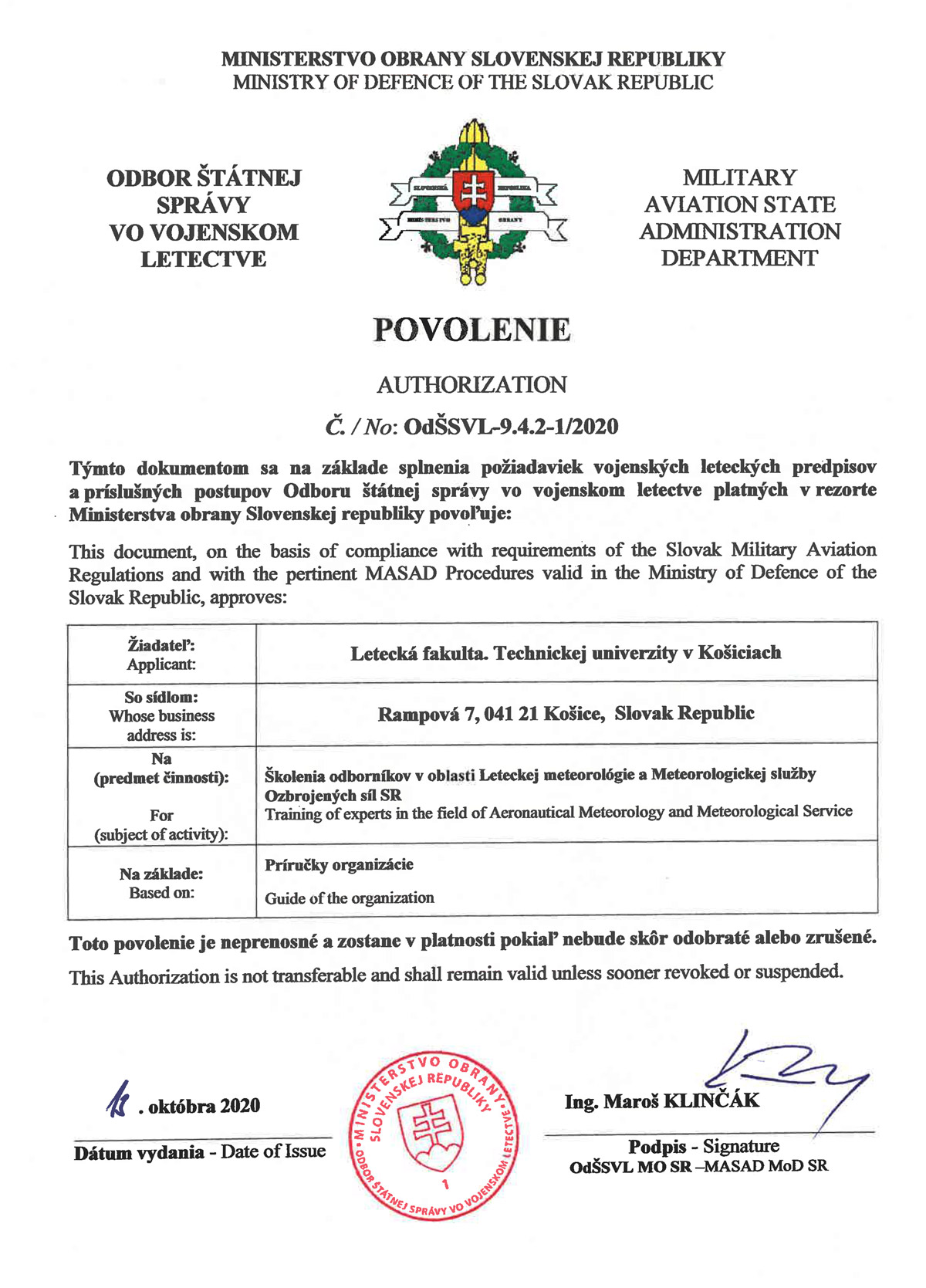Meteo organization
Meteo Organization for education in the field of Aviation Meteorology and the Meteorological Service of the Slovak Armed Forces.
The Faculty of Aeronautics of TUKE offers education/training in the field of training experts in the field of Aviation Meteorology and the Meteorological Service of the Slovak Armed Forces.
The training organization for the training of experts in the field of Aviation Meteorology and the Meteorological Service of the Slovak Armed Forces is integrated into the structures of the LF, at the Department of Flight Training.
Entry Requirements
The condition for admission to the training course for experts in the field of Aviation Meteorology and the Meteorological Service of the Slovak Armed Forces is to achieve a complete secondary or complete secondary professional education and to register for the course on the prescribed form "Declaration of Course Participant".
Course Objectives
The goal of the course is to provide graduates with knowledge and skills for the professional processing of meteorological materials and the provision of meteorological products to flying personnel, headquarters and staff during the tactical and operational phase of the decision-making and planning process.
The training organization takes into account the following valid legislation of the Armed Forces of the Slovak Republic:
- Military flying regulations
- SPA-2-3/MET
- Regulation LET-10-2
- Regulation LET-10-3/1
- Regulation LET-10-3/2
- Regulation LET-10-4
- Regulation LET-10-5.
- Commission Implementing Regulation (EU) 2017/373 of March 1, 2017 Article 6 letter e)
- Annex Vto ED decision 2017/001/R, Acceptable Means of Compliance (AMC) and Guidance material(GM) to Part-MET, Specific requirements for providers of meteorological services
- EASA Annex I – Part FCL, SUBJECT 050 – METEOROLOGY, p. 496 to 532
- ICAO Annex 3 to the Convention on Civil Aviation Meteorological Service for International Air Navigation
The training of experts in the field of Aviation Meteorology and experts of the Meteorological Service of the Ground Forces is carried out in the following blocks:
BLOCK I. GENERAL METEOROLOGY
- Atmosphere: composition, range, vertical division, atmospheric elements and phenomena, temperature, heat transfer, vertical temperature gradient, daily and annual course, pressure, isobars, pressure reduction, pressure lower/higher in the ground layer and at height.
- Atmosphere: density, relationship of pressure, temperature and density, international standard atmosphere ISA, barometric height measurement - principle.
- Atmosphere: barometric height, density height, actual height, height above the airport, altitude, flight level, pressure and temperature correction, orographically accelerated flow.
- Wind: definition and measurement, generation of wind, pressure gradient force, Coriolis force, friction force, centrifugal force, geostrophic and gradient wind, change with height and temperature, turbulence, standing waves.
- Wind: general (global) circulation, secondary circulation, local winds, catabatic anabatic wind, breeze, jet stream, CAT.
- Thermodynamics: humidity, water vapor pressure, specific, relative and absolute humidity, mixing ratio, dew point, state changes, latent heat.
- Thermodynamics: unsaturated and saturated adiab., stable and unstable stratification, convection, convective clouds.
- Cloudiness: formation of clouds, convection, advection, types of clouds, influence of stratification on development and weather r of clouds, flight conditions in individual types of clouds.
- Visibility: fog, smoke, haze, radiation, advection, and evaporative fog, frontal fog, orographic fog, industrial dust haze.
- Precipitation: formation of precipitation, types of precipitation depending on the type of cloud cover, transformation of precipitation in clouds.
- Air masses and fronts: types of air masses, frontal interfaces between air masses, warm front, cold front, stationary front, warm sector, front occlusion, life cycle of fronts.
- Pressure systems: position of main pressure formations, anticyclones, ridges, subsidence, non-frontal cyclones, wakes, secondary and orographic lows, tropical cyclones.
- Climatology: climatic regions, tropical climatology, intertropical convergence zone, monsoon, trade winds, easterly waves, typical situations in p. Europe, local weather, seasonal winds.
BLOCK II. AVIATION METEOROLOGY
- Icing: formation and growth conditions, types of icing, risks of flying in icing conditions, circling forecasting methods.
- Turbulence: formation, types, effects on flight, cloud-free turbulence (CAT), wind shear, definition, formation conditions, flight risks, forecasting methods.
- Thunderstorms: formation conditions, structure, developmental stages, squall line, storm cells, electrical phenomena, effects of lightning, downburst, microburst, avoiding storms, conditions for tornado formation, forecasting methods.
- Inversion and stratosphere: ground and high inversion, conditions in the tropopause and in the stratosphere, effect on aircraft performance, effect of ozone and radiation.
- Flying in the mountains: orographic effects on clouds and precipitation, frontal movements, vertical movements, waves, wind shear, turbulence, icing, valley inversions.
- Reduced visibility: smoke, smoke, sand dust, precipitation, drifting snow, micrometeorology, forecasting methods.
- Meteorological observations: ground observation, observation in the upper layers, satellite observations, radar observation, reports from aircraft.
- Meteorological maps: maps of significant weather, ground maps, height maps.
- Symbols on the maps: pressure formations, fronts, precipitation, fogs, dangerous phenomena.
- Aviation meteorological reports: METAR, TAF, SPECI, SIGMET, SNOWTAM, GAMET, runway status.
- Meteorological radio reports: VOLMET, ATIS, HF-VOLMET.
- Pre-flight information: documentation, meteorological briefing.
- Special warnings: low level wind shear, inversions, SIGMET VA, Radioactive MaterialWarnings, ground preparation.
BLOCK III. PRACTICAL EXERCISES
- Analysis of ground maps.
- Analysis of maps of absolute and relative topography.
- SKEW-T analysis.
- Interpretation of satellite radar images.
- Basic forecasting methods of temperature, wind, visibility, formation and disintegration of fog, forecasting clouds, storms, turbulence and frost.
- Meteorological briefing.
- Practical examination.
Contact
Technical University in Košice
Faculty of Aeronautics
Training organization for ATC basic training
Rampová 7
041 21 Košice
Security of courses
Responsible person: Ing. Ladislav Choma
Email: ladislav.choma@tuke.sk
 |
Education permittion in the field of aviation meteorological service issued by the in Air Force Department of State Administration of the Ministry of Defense of the Slovak Republic |


